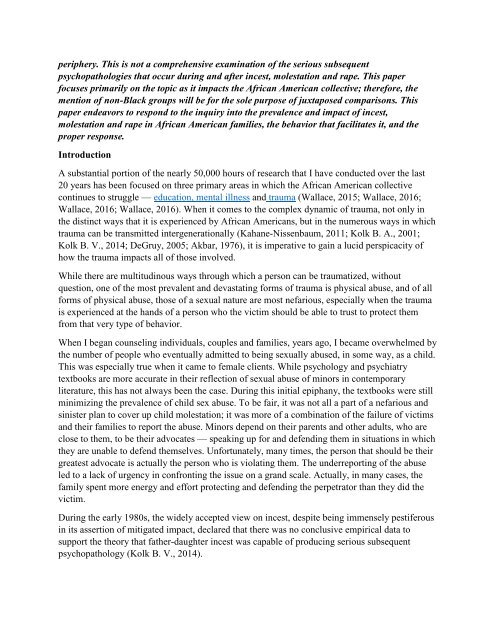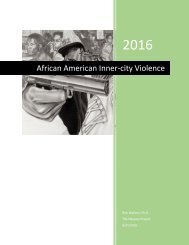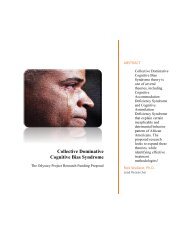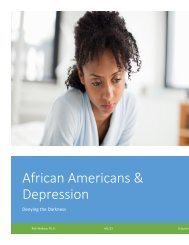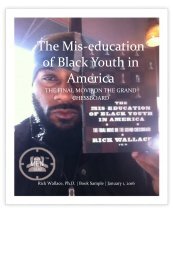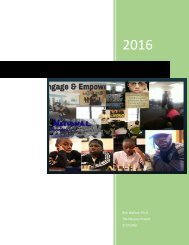Molestation, Incest and Rape in African American Families
While the subject of child molestation and incest remain a taboo topic, within the African American collective, its prevalence and impact can no longer be ignored. When perusing psychology textbooks on incest and molestation, especially the older ones, it is easy for a psychology student to develop an impression that molestation, incest and rape within the family environment is extremely rare; however, when engaging professional therapists (psychiatrists, psychologist, cognitive therapists, etc.) on the matter, it becomes obvious that this type of trauma is immensely prevalent, but that it also has an immense impact on the long-term success of the victim. The purpose of this brief treatise on this particular topic is to expand the superficial knowledge on the subject, while illuminating the manner in which this type of trauma can negatively impact the life of the victim and those within their periphery.
While the subject of child molestation and incest remain a taboo topic, within the African American collective, its prevalence and impact can no longer be ignored. When perusing psychology textbooks on incest and molestation, especially the older ones, it is easy for a psychology student to develop an impression that molestation, incest and rape within the family environment is extremely rare; however, when engaging professional therapists (psychiatrists, psychologist, cognitive therapists, etc.) on the matter, it becomes obvious that this type of trauma is immensely prevalent, but that it also has an immense impact on the long-term success of the victim. The purpose of this brief treatise on this particular topic is to expand the superficial knowledge on the subject, while illuminating the manner in which this type of trauma can negatively impact the life of the victim and those within their periphery.
You also want an ePaper? Increase the reach of your titles
YUMPU automatically turns print PDFs into web optimized ePapers that Google loves.
periphery. This is not a comprehensive exam<strong>in</strong>ation of the serious subsequent<br />
psychopathologies that occur dur<strong>in</strong>g <strong>and</strong> after <strong>in</strong>cest, molestation <strong>and</strong> rape. This paper<br />
focuses primarily on the topic as it impacts the <strong>African</strong> <strong>American</strong> collective; therefore, the<br />
mention of non-Black groups will be for the sole purpose of juxtaposed comparisons. This<br />
paper endeavors to respond to the <strong>in</strong>quiry <strong>in</strong>to the prevalence <strong>and</strong> impact of <strong>in</strong>cest,<br />
molestation <strong>and</strong> rape <strong>in</strong> <strong>African</strong> <strong>American</strong> families, the behavior that facilitates it, <strong>and</strong> the<br />
proper response.<br />
Introduction<br />
A substantial portion of the nearly 50,000 hours of research that I have conducted over the last<br />
20 years has been focused on three primary areas <strong>in</strong> which the <strong>African</strong> <strong>American</strong> collective<br />
cont<strong>in</strong>ues to struggle — education, mental illness <strong>and</strong> trauma (Wallace, 2015; Wallace, 2016;<br />
Wallace, 2016; Wallace, 2016). When it comes to the complex dynamic of trauma, not only <strong>in</strong><br />
the dist<strong>in</strong>ct ways that it is experienced by <strong>African</strong> <strong>American</strong>s, but <strong>in</strong> the numerous ways <strong>in</strong> which<br />
trauma can be transmitted <strong>in</strong>tergenerationally (Kahane-Nissenbaum, 2011; Kolk B. A., 2001;<br />
Kolk B. V., 2014; DeGruy, 2005; Akbar, 1976), it is imperative to ga<strong>in</strong> a lucid perspicacity of<br />
how the trauma impacts all of those <strong>in</strong>volved.<br />
While there are multitud<strong>in</strong>ous ways through which a person can be traumatized, without<br />
question, one of the most prevalent <strong>and</strong> devastat<strong>in</strong>g forms of trauma is physical abuse, <strong>and</strong> of all<br />
forms of physical abuse, those of a sexual nature are most nefarious, especially when the trauma<br />
is experienced at the h<strong>and</strong>s of a person who the victim should be able to trust to protect them<br />
from that very type of behavior.<br />
When I began counsel<strong>in</strong>g <strong>in</strong>dividuals, couples <strong>and</strong> families, years ago, I became overwhelmed by<br />
the number of people who eventually admitted to be<strong>in</strong>g sexually abused, <strong>in</strong> some way, as a child.<br />
This was especially true when it came to female clients. While psychology <strong>and</strong> psychiatry<br />
textbooks are more accurate <strong>in</strong> their reflection of sexual abuse of m<strong>in</strong>ors <strong>in</strong> contemporary<br />
literature, this has not always been the case. Dur<strong>in</strong>g this <strong>in</strong>itial epiphany, the textbooks were still<br />
m<strong>in</strong>imiz<strong>in</strong>g the prevalence of child sex abuse. To be fair, it was not all a part of a nefarious <strong>and</strong><br />
s<strong>in</strong>ister plan to cover up child molestation; it was more of a comb<strong>in</strong>ation of the failure of victims<br />
<strong>and</strong> their families to report the abuse. M<strong>in</strong>ors depend on their parents <strong>and</strong> other adults, who are<br />
close to them, to be their advocates — speak<strong>in</strong>g up for <strong>and</strong> defend<strong>in</strong>g them <strong>in</strong> situations <strong>in</strong> which<br />
they are unable to defend themselves. Unfortunately, many times, the person that should be their<br />
greatest advocate is actually the person who is violat<strong>in</strong>g them. The underreport<strong>in</strong>g of the abuse<br />
led to a lack of urgency <strong>in</strong> confront<strong>in</strong>g the issue on a gr<strong>and</strong> scale. Actually, <strong>in</strong> many cases, the<br />
family spent more energy <strong>and</strong> effort protect<strong>in</strong>g <strong>and</strong> defend<strong>in</strong>g the perpetrator than they did the<br />
victim.<br />
Dur<strong>in</strong>g the early 1980s, the widely accepted view on <strong>in</strong>cest, despite be<strong>in</strong>g immensely pestiferous<br />
<strong>in</strong> its assertion of mitigated impact, declared that there was no conclusive empirical data to<br />
support the theory that father-daughter <strong>in</strong>cest was capable of produc<strong>in</strong>g serious subsequent<br />
psychopathology (Kolk B. V., 2014).


